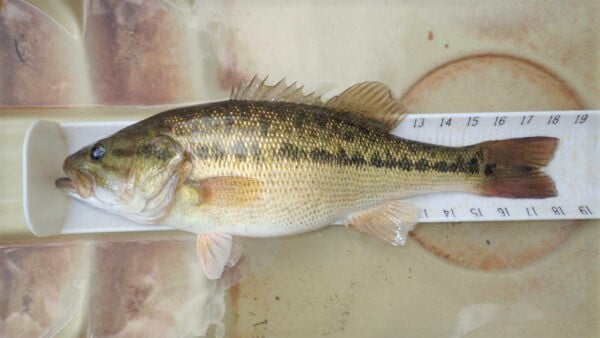
Photo courtesy of Va. Dept. of Natural Resources – An invasive species, the Alabama bass is a threat to largemouth and smallmouth bass fisheries.
In Virginia, the Alabama bass is an aggressive invasive species that outcompetes largemouth bass and readily hybridizes with smallmouth and spotted bass.
Alabama bass are native to Georgia and Alabama, occurring primarily in large river systems and large impoundments. They are confirmed to be present in Lake Gaston, Claytor Lake, Philpott Lake and Martinsville Reservoir. They are suspected to be present in Diascund Reservoir and possibly other lakes. The Department of Natural Resources is conducting genetic testing to better identify the extent of Alabama bass throughout Virginia.
They represent a tremendous threat to largemouth and smallmouth bass fisheries. Largemouth and smallmouth bass are Virginia’s most popular angling targets with more than 60% of anglers targeting either species over the course of a fishing season.
Largemouth and smallmouth bass fisheries in Virginia are valued in the millions of dollars. Declines in either population will result not only in the loss of sportfishing opportunities, but in economic harm to the region.
As an invasive species, Alabama bass are capable of outcompeting largemouth bass, causing declines in abundance. For example, in Lake Norman, North Carolina, the relative abundance of largemouth bass decreased to less than 8% of their former abundance following the introduction of Alabama bass. Declines in Largemouth abundance seem to be most pronounced in lakes that are relatively clear and that have limited vegetation.
Systems in Virginia such as Smith Mountain Lake, Lake Anna, South Holston Reservoir and Lake Moomaw are likely to see declines of largemouth bass populations if Alabama bass are introduced into those waterbodies.
Alabama bass also can hybridize with smallmouth or spotted bass, often resulting in loss of the genetically pure smallmouth bass population. This occurred in the Chatuge Reservoir in Georgia and North Carolina, and the Nottely Reservoir in Georgia. Smallmouth bass populations in lakes such as Smith Mountain and Moomaw, as well as in rivers such as the James and Shenandoah, might undergo a similar fate following the introduction of Alabama bass.
Although large Alabama bass may appear for a few years following introduction, this situation is short-lived and occurs primarily when population densities are low. Once established, Alabama bass populations often increase to the point where stunting occurs, resulting in a greater abundance of smaller bass. Fisheries are likely to shift from being dominated by 2–3 lb largemouth or smallmouth bass to being dominated by 1–lb Alabama bass.
Anglers are the primary vector for the spread of Alabama bass in Virginia. Current populations are the results of angler introductions that have occurred over the last ten years.
Anglers are reminded that it is illegal to stock fish into a public body of water without an authorization from the Department of Natural Resources. Anyone with knowledge of intentional stockings of Alabama or spotted bass should contact DNR law enforcement at 800-237-5712.
Anglers who suspect they have captured an Alabama bass should take a picture of the fish, clip off a thumbnail-sized portion of one of the pelvic fins and store the fin clip dry in an envelope. The pelvic fins are located on the bottom of the fish, just under the head. The angler should then either contact the DNR at 804-367-1293.


